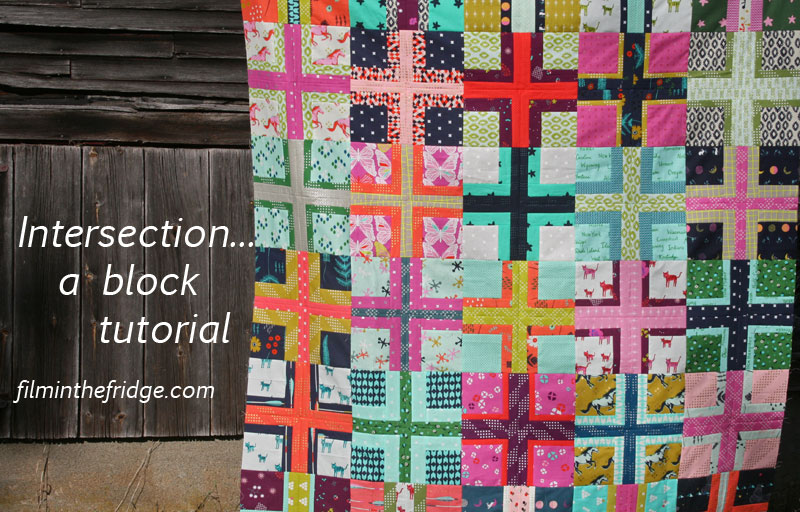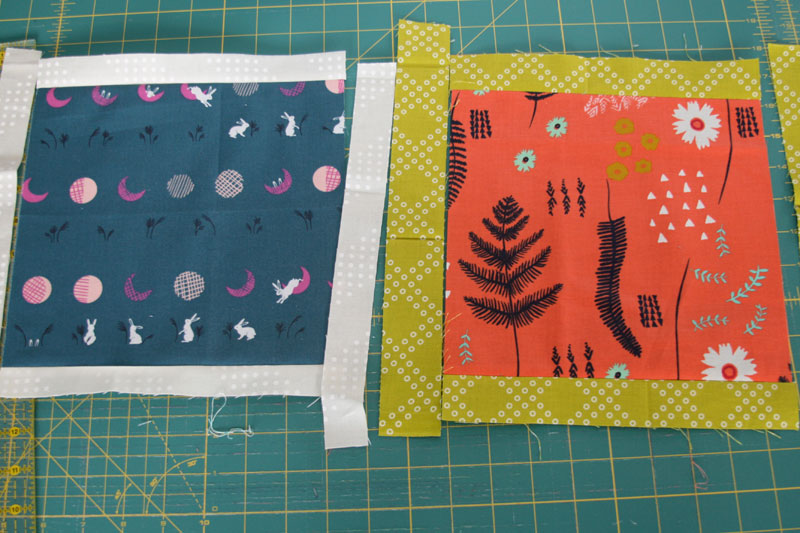Thanks for all the love on my latest quilt top. I’m glad you like it and I’m happy that I thought ahead and snapped a few photos so I could share this quick, albeit wordy tutorial!
This quilt looks more difficult than it is — in reality it’s pretty quick to put together and gives you lots of opportunities to put together fun fabric pairings. (In fact, it may take you longer to decide on fabric groupings than it does to sew the blocks together!) Make it in a wide variety of prints like the one shown, or decide on a more limited color palette. It would also look great in all solids.
You may want to take a read through the tutorial prior to starting, as there are a few notes throughout.
Intersection block:
11 1/2″ block
seam allowance is 1/4″ throughout
A few measurements…
Note: If you want all your corners and rings to line up, just select one of these sets of measurements and use the same for all your blocks. Alternatively, you could select to have all your corners line up and the plus sign widths vary by using the same center measurement and the variety of measurements for the rings. Or you could construct it as I did for the sample quilt top where I used a mix of all these measurements and didn’t worry about the corners or rings lining up.
The first ring requires a strip measuring about 34″ – 40″ in length (depending on the center square measurement) – 1 strip x WOF if cutting from yardage, or 2 strips cut from a FQ.
The second ring requires a strip measuring about 40″ – 52″ in length (depending on the center square measurement and first ring width) – 1-2 strips x WOF if cutting from yardage, or 3-4 strips if cutting from a FQ.
[due to the nature of this free tutorial, I will not be providing additional fabric requirements or specific cutting instructions. I hope you understand!]
Ready? Let’s get to making blocks!
Cut a center square according to the measurements above. Decide on the width for the first ring (again, following the measurements provided above, or adjusting them to suit your needs) and cut two strips that measure at least as long as your center square.
Sew each strip to opposite sides of the center square, iron seams open, and trim edges.
Repeat to sew two additional strips to the remaining sides to finish the ring.
Trim edges so block is square (as you can see, the blocks may be different sizes depending on which measurements you’re using).
Cut strips of fabric for the second ring, and follow steps above to sew one strip to either side of the block. Iron, trim and repeat for remaining two strips.
Trim block to 12″ square.
Note: if you find your blocks aren’t quite the right size, just add 1/8″-1/4″ to the measurement for the second ring, then trim block down to size once the rings are sewn. I prefer making my blocks a bit bigger and then trimming down, rather than making sure my seam allowance is spot on.
Cut block in half vertically and then in half horizontally so you have 4 6″ squares.
Rotate the squares as shown so that the outer ring becomes the center plus.
Sew top two squares together and bottom two squares together and iron seams open.
Sew the two halves together and iron seam. Stand back and admire your lovely intersection block!
Repeat these steps to make as many more blocks as you need for your desired quilt size.
A few notes on fabric selection –
*directional prints work best for the center square of this block (directional prints work on the outer rings, just keep in mind that the prints will be sideways in places unless you adjust your cutting to ensure they’re all facing the right way as you sew your rings).
*the outer ring of the block becomes the center plus sign, so I find that a smaller print works better here. You’ll note what happens with a larger print (especially if it’s not straight!) in the block above on the right – and yes, I did end up ripping it out after the block was sewn together because it was driving me nuts!
*it’s also helpful to think about contrast between your fabrics, especially between the fabric in the center square and the fabric in the first ring. This first ring ends up being the outside of the plus sign, and I think it looks best if doesn’t blend too much with the print/colors of the center square.
I hope you’ll have fun making this block and I look forward to seeing them! Be sure to use #filminthefridge or #fitfquilts on Instagram so I can see them.
_
_
Like this tutorial and want to make a donation? [paypal-donation]












 intersection
intersection




Pingback: FITF: intersections quilt | Film in the Fridge
Pingback: Another Chopped Block and Crumb Star Pillow | QUILTArtbymegan
Pingback: September Charity Bee Block |
Pingback: FITF: the intersection of Friedlander and Carkai | Film in the Fridge
Pingback: Snatch My Weave Cushion – Molli Sparkles
Pingback: Block of the Every Other Month – Intersections – Due June 2021 – South Bay Area Modern Quilt Guild